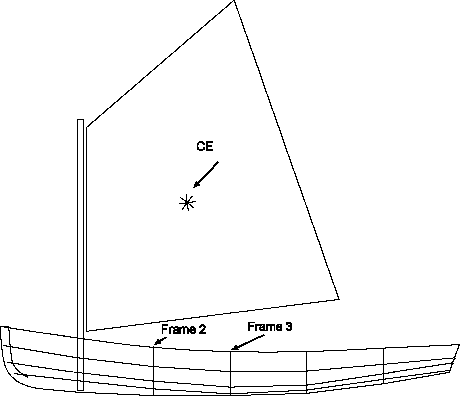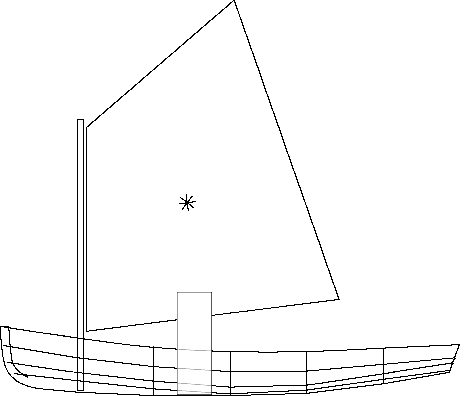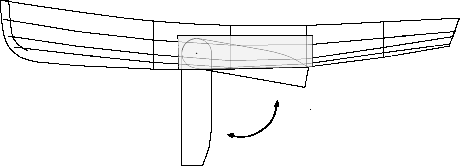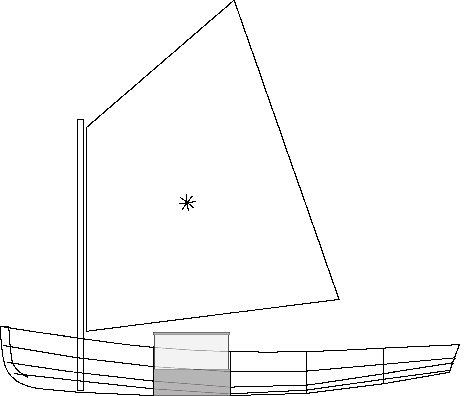|
The Daggerboard and Daggerboard
Trunk My 'big plan' for this boat is to use it in the Texas 200, a 200 mile long boat camping trip in along the Texas Gulf Coast. This is a stupid idea and an inappropriate boat, but that's how I roll, so there. BACKGROUND FOR MY NON-SAILING FRIENDS A boat sails by balancing the pressure from the wind against the pressure from the water. The wind pushes against everything above the water - the sides of the boat, the sail, the people, etc. and the water presses against everything below the water: The wetted area of the hull, the rudder, and the centerboard (if hung off the side of the boat, the centerboard is called a leeboard. If the centerboard can be raised, lowered, or removed completely, through a slot, it is usually called a daggerboard.) Depending on the direction of travel and position/shape of the sail, the wind either pushes or pulls on the sail, this force is concentrated on the geometric center of the sail and is called the Center of Effort (CE.) A boat balances this pressure over (or near) the centerboard. The centerboard tries to hold the boat from slipping sideways (leeward) and gives the wind something to push/pull against, allowing the boat to move. The rudder rotates the boat around the centerboard, allowing the boat to be steered. Collectively, the rudder and centerboard are called foils. If the pressure from the wind overcomes the foils ability to control the boat, the boat goes into 'hurricane mode' and the wind pushes it any old which way the wind feels like pushing it - think of an empty Dixie Cup on a pond. THE TEXAS 200 In the three Texas 200s I've participated in, the winds have been up to and over 20 knots (23mph and up to land lubbers.) That's a lot of wind in a small boat. Heck, that's a lot of wind, period. The good news is that the route is nearly all North or North North East and the wind is nearly all from the South or South South East. Sometimes it veers to Easterly, and then little boats can get blown to leeward (to the West,) into the dreaded lee shore. The Texas 200 is also very (very) shallow, meaning it is easy to be surrounded by miles of water, but still be stuck if too much of your boat sticks beneath the surface. DESIGN CONSIDERATIONS The trick to a good sailing boat is to balance the Center of Effort over (or slightly ahead of) the center of the centerboard. This Whitehall design has the mast placed so the CE of it's 45sqft spritsail is just slightly ahead of dead-center between Frames 2 and 3.
The centerboard is subjected to a fair amount of force - especially during unintended goundings. Having it braced between the frames is ideal. Now, what kind of centerboard to use? When I was active in the Puddle Duck Racer world, I got to get some one on one advice from Mik Storer, a boat designer from Australia. He believes (and rightly so) that a racing dinghy needs a deep, narrow, well-shaped, centerboard - About a foot wide and sticking down in the water about 3ft. This gives an excellent pivot point for the boat and allows fantastic control from the rudder. On this boat, it'd look like this:
which is fine, except for the fact I am a terrible navigator and often run into shallow waters. If I did happen to run aground, I could pull the board up, but it'd be so long it'd interfere with the sail.
This would be the most economical, best performing setup, but I am terrified of having my sail catch on the raised centerboard during an emergency. I've seen it happen, and it ain't pretty. I could make a swinging leeboard - one that tucks up neatly into the belly of the boat when running in the shallows. This is an elegant solution, and if you use a weighted board, you just drop it and forget it - if it hits something, it just bounces up, then swings back down when there's room.
The problem here is the internal structure - I have to make a box (called a trunk) that can house the entire swinging leeboard when it is in the up position, and that takes up a LOT of real estate, right where I'll be wanting to put my legs.
While I love the "drop it an forget it" nature of a swinging centerboard, I also know the Texas 200 is a grueling endurance event, and I'm going to want each tiny bit of comfort I can get. A 'Shoal Draft' daggerboard is a compromise between a long, narrow daggerboard and a swinging centerboard. It is not nearly as deep as a daggerboard, but you do get a lot of wetted surface area to help prevent leeway. You can't point as high into the wind, but you are also less likely to run aground.
This'll give a little over 2sqft of wetted area while still allowing the sail to swing freely even when the board is up.
There is an additional advantage here: If I decide the shoal draft board is not enough I can alter the trunk so it fits a daggerboard and maybe make a taller mast. Or maybe I can just get over my fear of having the sail hang up on a raised daggerboard.
|








